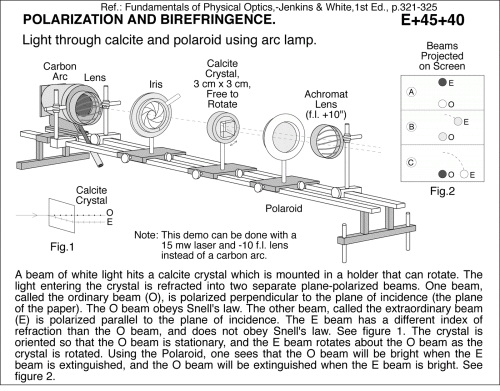Light through polaroid and calcite, using arc lamp.
Primary tabs
A beam of white light hits a calcite crystal which is mounted in a holder that can rotate. The light entering the crystal is refracted into two separate plane-polarized beams. One beam, called the ordinary beam (O), is polarized perpendicular to the plane of incidence (the plane of the paper). The O beam obeys Snell's law. The other beam, called the extraordinary beam (E) is polarized parallel to the plane of incidence. The E beam has a different index of refraction than the O beam, and does not obey Snell's law. See figure 1. The crystal is oriented so that the O beam is stationary, and the E beam rotates about the O beam as the crystal is rotated. Using the Polaroid, one sees that the O beam will be bright when the E beam is extinguished, and the O beam will be extinguished when the E beam is bright. See figure 2. Light through calcite and polaroid using arc lamp. Ref.: Fundamentals of Physical Optics,-Jenkins & White,1st Ed., p.321-325 This demo can be done with a 15 mw laser and -10 f.l. lens instead of a carbon arc. Note: Beams Projected on Screen
UCB Index:
E+45+40
PIRA Index:
6H35.10
Demo Picture:
UCB Taxonomy:
Popularity:
- Log in to post comments

